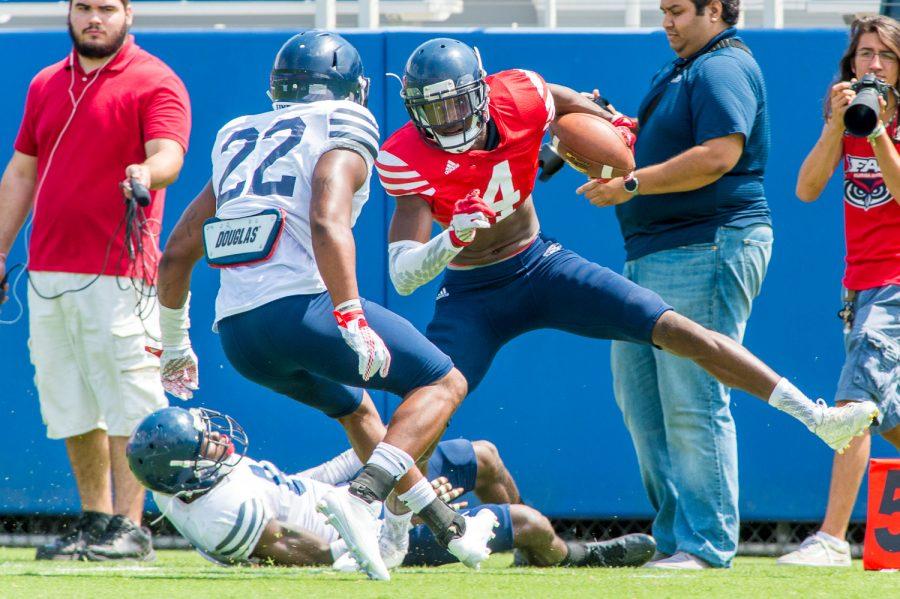Football: FAU protecting its players from injuries in spring practices
Staying up and wearing knee braces are just some ways the Owls help its players healthy.
Rising senior wide receiver Kalib Woods (4) led the team in receiving a season ago. Photo by Max Jackson
March 24, 2017
Toward the end of practice, with the sun blazing down on the Florida Atlantic football players and coaches, redshirt junior wide receiver Bobby Mitchell lined up on the right side of the field, with sophomore cornerback Chris Tooley closely watching him.
As redshirt sophomore quarterback De’Andre Johnson got the snap and dropped back, Mitchell used his quickness to juke Tooley, then sprinted down the sideline like a rocket. Tooley, falling behind the speeding Mitchell, refused to give up on the play and chased him down.
Johnson recognized that Mitchell had the step, so and launched the football downfield. Tooley was able to catch up just in time, but he failed to slow down in time and crashed into Mitchell as he attempted to catch the football.
Both players went down, appearing to be in a significant amount of discomfort as team medical personnel attended to them on field. Mitchell eventually walked off the field limping, but Tooley stayed for a while, grimacing with pain.
These sorts of injuries happens often in football, but it’s different when both players are not wearing pads. It’s a common occurrence in spring practice, as a player’s only protection is their helmet.
Both players were okay, and neither suffered any significant injuries. Mitchell and Tooley were able to participate in the next drill.
Different techniques are used to help keep the players safe during spring practice, where they usually practice with just shorts and helmets, such as always staying on your feet and two-hand touch football.
“We try to teach our guys to practice like pros,” said head coach Lane Kiffin. “We still go full-speed. We can [avoid injuries], you just have to teach them and show them on tape what to do and what not to do.”
However, Kiffin mentioned because of the competitive nature of the sport and his players, an occasional tackle will be made, which could lead to injuries with such limited protective gears.
“We were better today than we were Tuesday doing it,” said Kiffin.
FAU’s offensive line is the lone group on the football field which gears up extra protection: a knee brace. Due to their roles and position on the field, the knee brace is mandatory for every practice to avoid any significant injuries.
A lot of schools require its offensive linemen to take part of what is known as the prophylactic bracing, including FAU. The premise is that the brace is needed to protect the vulnerable joints of linemen, who are hit on the side or the back of a knee by other players who are falling in the so-called trenches near the line of scrimmage.
“You always want to wear them when you are in practice,” said Kiffin of the knee brace. “Guys roll up on you and get injuries that would happen without them.”
On top of that, the offensive line was depleted with injuries last year, having used eight different starting combinations in 13 games last year. Reggie Bain, who was lost for the season last year after a car crash, welcomes the knee brace and the impact it has.
“Somebody hit you, you are going to go down regardless,” said Bain. “With the knee brace, it keeps your leg from moving in directions you wouldn’t want it to.
Bain, who who was named part of the 2016 Conference USA All-Conference team before his season ended prematurely, started all 24 games he’s played in since he came to FAU from Miami Central High School three years ago. Although he watched from the sidelines last year, he’s excited about getting back on field in the fall.
“I am just glad to be back out here,” Bain said.
Hans Belot Jr. is the sports editor of the University Press. For information regarding this or other stories, email [email protected] or tweet him at @Don_Phenom_.






